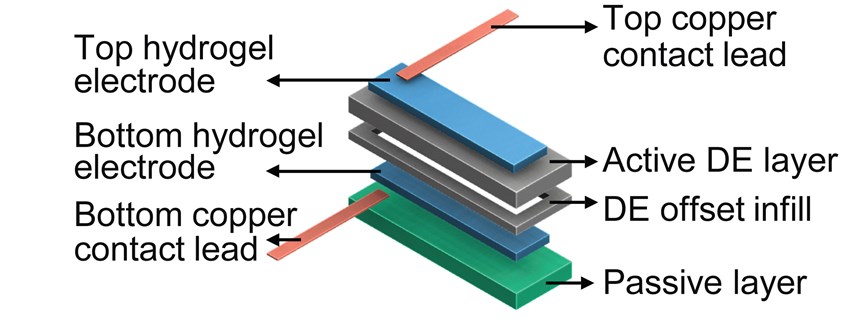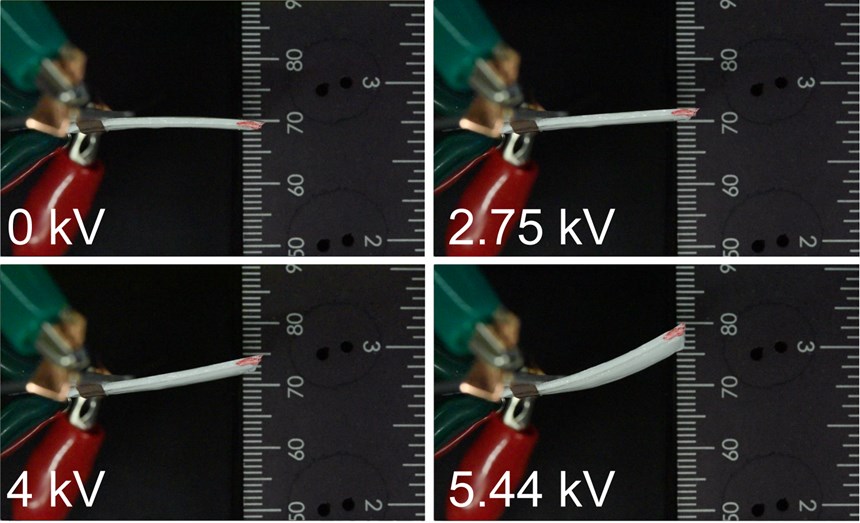Share
Broadly speaking, humans have focused our engineering on brute-force mechanical processes because we’ve lacked the technical capacity to mimic nature. This isn’t for a lack of imagination on our part. Leonardo da Vinci modeled his schematics for human flight based on the observations of birds back at the start of the 16th century. But the technological capability to engineer and manufacture the complex geometries and mechanics of living organisms—the natural geometries, material properties and mechanics that have evolved and improved over the course of eons—has been largely absent until recent innovations in materials development and additive manufacturing.
This nature-mimicking concept, called biomimetics, inspired a recent breakthrough made by researchers working at the University of Minnesota (UofM) in the field of soft robotics. In an article published earlier this year in the journal Extreme Mechanics Letters, lead researcher and UofM Ph.D. candidate Ghazaleh Haghiashtiani helped demonstrate that, for the first time, dielectric elastomer actuators (DEAs) can be fully 3D printed and layered with soft ionic hydrogel-elastomer hybrid material systems. That’s a lot to unpack, but this capability holds promise for printing entire soft robots made from a material analogous to human skin—including its ability to carry and respond to electrical stimuli.
The materials at the center of Haghiashtiani’s research are ionic hydrogel-elastomer hybrids, formed by layering ionic hydrogels (soft, stretchable, transparent and conductive materials in which ions carry charges as opposed to electrons in conventional electrode components) and silicone-based dielectric elastomers (a type of electroactive polymer) in succession. When layered in this manner, this hybrid material system results in a structure that replicates the skin’s dermal and epidermal layers. While these materials have been researched and developed for years, never before have they been subject to 3D printing for fabricating functional actuators, largely because of the postprocessing necessary to bond the hydrogel inks (which are hydrophilic, i.e. can be mixed with or dissolved by water) with silicone-based materials (which are hydrophobic, i.e. repel water).
Haghiashtiani and her team applied a chemical treatment strategy on the silicone surface (with a solution including benzophenone photoinitiator), along with exposure to UV light, to create graft polymerization and chemical bonding between the hydrogel and elastomer surfaces. With this bonding between previously unprintable layers now possible, the research team was able to insert copper tape pieces as electrical contact leads into the device structure between layers as they were printed. The bottom electrical lead was inserted during the printing process before deposition of the hydrogel layer, while the top electrical lead was placed on top of the hydrogel layer after the printing was complete (see Figure 2).
None of this would have been achievable, however, without solving the other constraint to the printability of these materials: viscosity. (Or, to be more exact, the rheological properties of the materials, of which viscosity is a prime characteristic.) The extrusion-based printing process used for this study, direct ink writing, necessitated material characteristics that would decrease the viscosity of the inks as they flow through the deposition nozzle and become subject to higher pressures. This property is known as shear-thinning behavior. Through manipulation of the composition of both the hydrogels and the elastomer inks, Haghiashtiani and her team were able to optimize shear thinning behaviors specifically for their printer’s nozzle tip diameter, extrusion pressure and printing speed used in the UofM lab.
The printers themselves are custom-built devices that employ a gantry system along with a deposition-based robotic fluid dispenser made by Fisnar. The machines were originally housed at Princeton University, where this study’s principal investigator, Prof. Michael McAlpine (now at UofM) performed extensive research in 3D printing active materials.
For Haghiashtiani’s study, the finished test device consisted of several layers, including, from bottom to top, a passive layer with a bottom electrode placed on top, followed by the dielectric elastomer, topped by another electrode. On this device, the team conducted performance tests across several conditions to measure the responsiveness to electrical stimuli, including step changes in applied voltage to the electrical leads (see Figure 3). “In a fundamental DEA configuration, when you apply electric voltage,” Haghiashtiani told me, “you are going to see that the dielectric elastomer expands in area, while its overall thickness shrinks. In the bending DEA, the stiffer passive layer imposes a restriction on the structure, resulting in translating the in-plane deformation to out of plane bending motion.”
In order to keep the two electrodes from coming into contact with each other and shorting the device, the team printed the hydrogel electrodes with an offset of 2 mm from each side on the corresponding passive layer and the dielectric elastomer layer. They added barium titanate nanoparticles to the silicone layer to enhance the overall electromechanical sensitivity of the device, and tested different applied voltages to measure the DEA performance in lifting small payload masses placed at the device’s tip.
...the path exists for someday 3D printing self-sensing, soft robotic systems that mimic the abilities of natural muscle, including neurons that “provide a sense of spatial position and motion.”
The results of these tests led Haghiashtiani to conclude that not only are 3D-printed soft dielectric elastomer actuators capable of generating movement and motion, but that the path exists for someday 3D printing self-sensing, soft robotic systems that mimic the abilities of natural muscle, including neurons that “provide a sense of spatial position and motion.” Partly because this research was conducted with the U.S. Army Research Lab, media attention paid to Haghiashtiani’s article was almost entirely focused on the potential military applications that this technology promises. News articles about the research often featured stock photos of octopuses and squids below headlines that claimed that the U.S. Army is building “squid-like” soft robots that can maneuver within confined and congested spaces. This may someday be possible, but these soft devices and stretchable electronics include mechanical energy harvesting devices, actuators, flexible circuit boards and electroluminescent skins—applications that could resonate in numerous fields.
That’s not to say that untethered mechanical systems and soft robots don’t hold distinct interest to the military. But Haghiashtiani sees other, perhaps shorter-term applications in the field of smart prosthetics. Still, there is work to be done. “Right now the level of voltage required to activate these devices is probably too high,” she says. “The voltage is at the kilovolt range, which is why there is reluctance to use this for medical applications in general. This work is just scratching the surface. Using this type of 3D printing for making soft actuators—there is more work that needs to be built upon this to improve the performance of devices and develop them into more complex structures that can be readily functional right off the printer.”
Related Content
Sintavia Develops Niobium Printing Technology for Aerospace, Defense
C103 material parameter specification is said to enable full alloy adoption across defense and space applications.
Read More3D Printed Replacement Clamp for an F-16 Aircraft: The Cool Parts Show #54
3D printing is a valuable addition to sustainment programs, but only if printed parts can be qualified as fast and flexibly as they can be made. In this episode of The Cool Parts Show, we look at the clamp that won the Air Force’s Approval Sprint Challenge designed to address this need.
Read More7 Takeaways From America Makes MMX 2023
America Makes just held its recent Members Meeting & Exchange. Here are observations related to cost and collaboration; digital manufacturing; and the sustainment and supply chain needs of the DoD.
Read MoreNew Zeda Additive Manufacturing Factory in Ohio Will Serve Medical, Military and Aerospace Production
Site providing laser powder bed fusion as well as machining and other postprocessing will open in late 2023, and will employ over 100. Chief technology officer Greg Morris sees economic and personnel advantages of serving different markets from a single AM facility.
Read MoreRead Next
Hybrid Additive Manufacturing Machine Tools Continue to Make Gains (Includes Video)
The hybrid machine tool is an idea that continues to advance. Two important developments of recent years expand the possibilities for this platform.
Read MoreAt General Atomics, Do Unmanned Aerial Systems Reveal the Future of Aircraft Manufacturing?
The maker of the Predator and SkyGuardian remote aircraft can implement additive manufacturing more rapidly and widely than the makers of other types of planes. The role of 3D printing in current and future UAS components hints at how far AM can go to save cost and time in aircraft production and design.
Read More3D Printing Brings Sustainability, Accessibility to Glass Manufacturing
Australian startup Maple Glass Printing has developed a process for extruding glass into artwork, lab implements and architectural elements. Along the way, the company has also found more efficient ways of recycling this material.
Read More

























